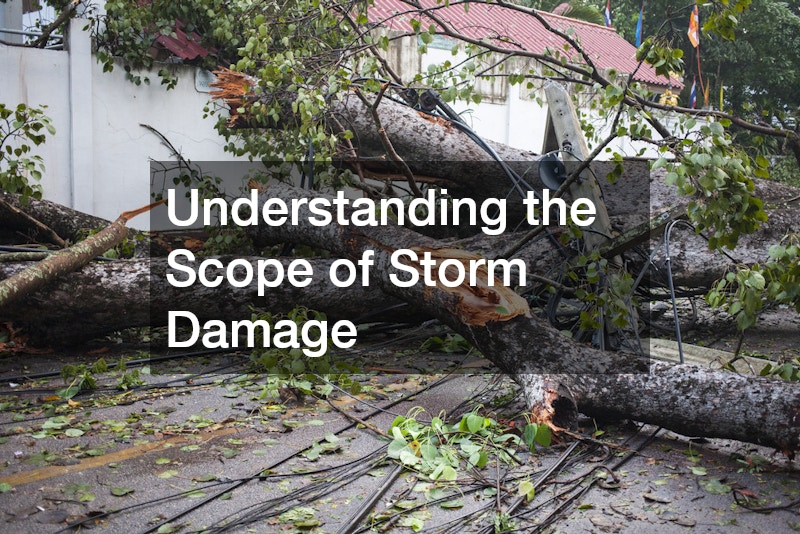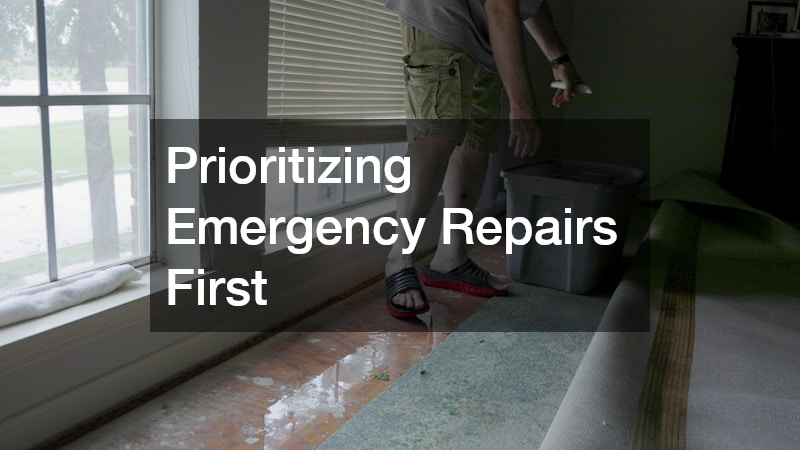When a severe storm passes through your neighborhood, the aftermath can leave homeowners feeling overwhelmed and unsure of what to do next. From broken windows and fallen trees to roof leaks and structural damage, storms can affect nearly every part of your home. The path to recovery involves more than just fixing what’s visibly broken—it’s a process that requires careful planning, coordination with professionals, and an understanding of what to expect at each step. Storm repairs can vary greatly depending on the intensity of the weather event and the age or condition of the home, but knowing how to respond can help you regain a sense of control.
Taking the right steps immediately after a storm can make the difference between a smooth recovery and prolonged stress. While it’s natural to want to dive straight into repairs, the reality is that storm repairs are often more complicated than they appear. Damage can be hidden beneath surfaces or within structural components, and timelines can shift due to permitting issues, weather delays, or contractor availability. By understanding the general flow of the repair process, you’ll be better equipped to protect your home, manage expectations, and restore your living space safely and efficiently.
Understanding the Scope of Storm Damage

The first and perhaps most critical step in dealing with repairs is understanding the full extent of the damage. After a storm, your home might look mostly intact on the outside while hiding more serious issues internally. Flooding can compromise foundations, wind can tear off roofing shingles, and flying debris can damage siding or break windows. It’s important to recognize that storm damage is not always visible at first glance, and a surface-level inspection may overlook hidden problems that could worsen over time. Taking a comprehensive look at all parts of your home—both inside and out—helps ensure that nothing is missed during the recovery process.
Specifically, the roof is often the area most vulnerable to storm damage. High winds, hail, and falling tree limbs can cause anything from minor leaks to large holes that expose your home to further weather conditions. Timely roof repair is essential not just to prevent water infiltration but also to maintain the structural integrity of your home. Any roof issues should be evaluated by a professional as early as possible in the repair process to avoid damage and delays.
Contacting Your Home Insurance Provider
Once the immediate safety concerns are addressed, contacting your home insurance provider should be one of your top priorities. Storm repairs can be expensive, and in many cases, homeowners are eligible for coverage that can offset the cost of restoring their property. However, managing the claims process can be overwhelming—especially when you’re already dealing with the emotional and logistical stress of storm damage. Promptly notifying your insurer, understanding your policy, and keeping detailed records will help ensure that your claim is processed efficiently and fairly.
In most cases, your home insurance policy will include specific guidelines for filing storm-related claims, such as deadlines for reporting damage and requirements for documentation. You may be asked to provide photos, repair estimates, or even allow an adjuster to inspect the property. Being proactive in this phase of repairs can prevent delays and misunderstandings. It’s also wise to clarify which types of repairs and materials are covered, as this can influence your choices when selecting contractors and repair methods later on.
Scheduling a Professional Damage Inspection

After the initial shock of the storm has passed and you’ve begun communicating with your insurance provider, the next vital step is scheduling a professional damage inspection. This ensures that all affected areas are accurately assessed—something that even the most vigilant homeowner may not be able to do alone. A professional inspector or licensed contractor will know how to identify both obvious and hidden damage that can result from high winds, heavy rain, hail, or debris impact. Thorough inspections are crucial because overlooking even small issues can lead to more serious problems down the line, making your storm repairs more costly and complicated.
Professionals will often evaluate structural components, the integrity of your roofing system, electrical systems, and vulnerable entry points such as doors and windows. For example, impact windows may appear unbroken but could have sustained hairline fractures or lost their sealing capacity, compromising your home’s weather resistance. These nuanced details are often caught only by trained eyes.
Documenting Damage for Insurance Claims
Properly documenting the damage to your home is essential for both financial recovery and a smooth insurance process. Before any cleanup or repair work begins, take the time to photograph every affected area from multiple angles. Include wide shots for context and close-ups for clarity. This documentation will serve as a record of the storm’s impact and provide your insurance provider with the evidence needed to justify repair costs. Clear records can also help resolve disputes, verify timelines, and support claims if additional damage is discovered later in the repair process.
In particular, visible elements like windows, doors, roofing, and shutters should be carefully documented, even if the damage seems minor. A cracked or warped shutter, for instance, may signal more extensive wind stress or structural strain in that part of the home. Including these smaller details in your records reinforces the full scope of your storm repairs and ensures that nothing gets overlooked when it comes time for reimbursement or contractor planning.
Prioritizing Emergency Repairs First

Not all repairs can—or should—wait. Once the inspection and documentation steps are complete, it’s important to address emergency repairs immediately to prevent further deterioration or safety hazards. These types of storm repairs may include patching roof leaks, securing broken doors, or boarding up shattered windows. The goal is to stabilize the home and protect it from additional weather exposure or intrusions until permanent fixes can be made. Failing to address urgent issues promptly can also impact your insurance coverage, as providers often require homeowners to take reasonable steps to mitigate further damage.
In some cases, specific areas like screen porches may need temporary reinforcement even if they aren’t a top structural concern. Torn screens, loose structure, or damaged enclosures can create safety issues, invite pests, or allow water to infiltrate adjacent indoor spaces. While not as critical as foundation or roofing issues, these kinds of repairs often fall under the category of essential stabilization during the early phase of storm repairs. Tackling these concerns early helps preserve your home’s livability and keeps the repair timeline on track.
Choosing the Right Repair Contractors
Finding reliable and qualified contractors is one of the most important steps in the repair process. With storm damage often affecting multiple parts of a home, you may need specialists for roofing, siding, windows, and more. It’s essential to vet each contractor carefully by checking credentials, reading reviews, and confirming licensing and insurance. Be cautious of opportunistic, out-of-town contractors who may arrive immediately after a storm—sometimes referred to as “storm chasers”—and offer quick, cheap fixes that don’t hold up over time. Investing the time to find trustworthy professionals ensures quality workmanship and lasting results.
In many cases, you’ll need more than general repair help, especially if outdoor spaces have been affected. If your outdoor living areas were damaged, working with a reputable patio installation company can restore more than just functionality—it can bring back comfort and curb appeal. Repairs aren’t only about fixing what’s broken but also about returning your home to its pre-storm quality. Specialists in exterior installations can help rebuild features like patios, decks, and outdoor kitchens in a way that’s both durable and aesthetically pleasing.
Managing Permits and Local Regulations

During storm repairs, many homeowners are surprised to learn just how many regulations and permit requirements are involved in even minor projects. Depending on your municipality, permits may be needed for electrical work, roofing, structural changes, or anything that alters the footprint or safety of your home. Skipping this step can result in fines, delays, or even forced removal of unapproved work.
Even seemingly minor updates—like replacing storm-damaged blinds or fixtures in a window—may trigger compliance issues if the windows themselves are being resized or replaced. Repairs often expose areas of the home that no longer meet modern codes, meaning you may be required to update those components as part of the process. While it can be frustrating to deal with red tape during an already stressful time, staying aligned with local rules protects your home’s value and prevents future legal headaches.
Managing Repair Timelines and Delays
Timelines for repair rarely go exactly as planned. Weather interruptions, supply shortages, labor availability, and inspection delays can all push your schedule back. That’s why it’s crucial to maintain flexibility and prepare for a phased approach to restoration. Open communication with your contractors, regular progress updates, and written agreements with clear timelines can help manage expectations and reduce frustration. Delays are often unavoidable, but how you plan for them can make the difference between a smooth and stressful experience.
This is especially true for custom or specialty items like awnings, which may take longer to replace due to material sourcing or fabrication requirements. If your home has storm-damaged awnings, expect that these components might extend your timeline more than basic structural repairs. When dealing with features that are more design-oriented or specific to your home’s layout, patience becomes a necessary part of the storm repairs journey. Being proactive about ordering and scheduling these elements can help minimize downtime and restore your home’s exterior comfort sooner.
Protecting Against Future Storm Damage
While repairing storm damage is essential, preventing future destruction is just as important. Once your repairs are complete, take time to evaluate what improvements could reduce the impact of future weather events. This might include reinforcing weak areas of your home, upgrading materials, or rethinking your landscaping to redirect water away from the foundation. Preparing in advance not only safeguards your home but also gives you peace of mind the next time a storm is on the horizon.
One smart upgrade is installing a gutter cover system, which helps keep debris out of your gutters and ensures proper water drainage during heavy rain. Clogged or overflowing gutters can lead to water damage around your roofline, siding, and foundation—issues that often require repairs. By investing in solutions that strengthen your home’s defenses, you can reduce your vulnerability and lessen the likelihood of needing extensive repairs after every storm season.
Coping With the Stress of Home Restoration
Dealing with storm repairs is not just a logistical challenge—it can be an emotional one, too. Watching your home suffer damage and navigating the long process of recovery can leave you feeling drained, anxious, or overwhelmed. It’s important to give yourself space to process the experience and to seek support from professionals, friends, or community groups if needed. Having a clear repair plan, realistic expectations, and trusted contractors can ease the burden significantly.
For example, something as visual and significant as siding repair can impact your perception of progress. Seeing your home’s exterior scarred or incomplete for weeks or months can take a toll on morale. However, restoring these visible parts of the home also offers an opportunity for renewal. You may opt for higher-quality materials or improved designs that better withstand future storms. Recognizing storm repairs as a journey—not just a task—can help you approach each step with more patience and resilience.
Rebuilding Smarter After the Storm
Recovering from a storm is never easy, but with the right approach, it can become an opportunity to strengthen, protect, and even improve your home. From the moment you assess the damage to the final stages of repair, each decision you make plays a role in the speed and success of your recovery. Being proactive, informed, and organized helps reduce setbacks and ensures that storm repairs are both thorough and lasting.
Beyond just restoring what was lost, the process offers a chance to make smarter choices for the future—whether that means installing more resilient windows, working with skilled professionals, or upgrading to materials that better withstand extreme weather. While storm damage can be disruptive, it doesn’t have to define your home’s story. With thoughtful planning and a steady mindset, you can come out of the experience not only repaired but renewed—ready to face the next storm with greater confidence.



